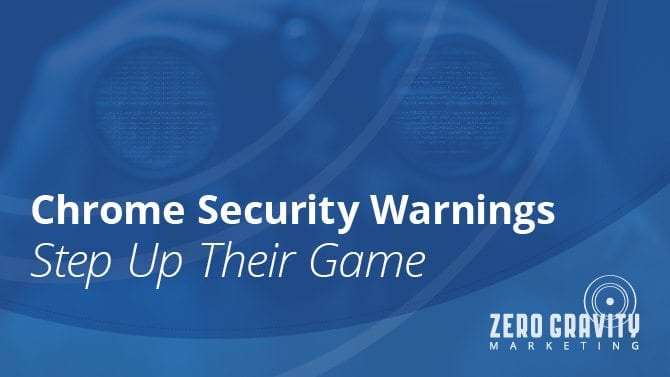
Earlier this year, Chrome (version 56) began notifying users if your site did not have an SSL certificate any time you asked for a password or payment information. This would let them know the information they were about to submit was not secure, allowing them to back out of the purchase before their information was transmitted.
However, Google just announced that starting in October of 2017, the Chrome security warnings are going to go a step further. With version 62 of Chrome, users will now be notified any time they enter text into a field box—even if it’s just an email address or phone number. The information no longer has to be payment related to receive the warning—any personal data qualifies. The Chrome security update will also flag any pages visited in Incognito mode.
What It Means
Google has not been secretive about their long-term mission to ensure all sites transmitting any personal data are secure. So this new change is just another step in that direction. Essentially, it means that if your website does not have an SSL certificate, you will probably scare away a lot of users who are about to give you valuable information.
After all, if it was you on the other side of the screen, would you click submit if the Chrome security warning popped up? Probably not. People using the internet expect their information to be secure, and if there is any indication it is not, they will not take any chances.
What an SSL Certificate Does
When someone visits your site, they expect their information to be private, and you don’t want to give them any reason to think otherwise. When they see you have a secure site (identified by the HTTPS at the beginning of your URL), they will trust you and feel confident in doing business with you. An SSL certificate protects your users in three ways:
- It encrypts all data that is being transmitted.
- It makes sure the data cannot be modified during the transfer.
- It verifies that you are who you say you are.
Take Action Now
Luckily, Google has given advanced notice of this Chrome security warning change. If your site does not have an SSL certificate, you have a little over a month to get one. That being said, it is crucial that you go through all of the proper steps to make the transition smooth. By adding the SSL certificate, you are changing the URL, which means 301 redirects are critical if you want to continue to be crawled and ranked by Google. It may seem like a lot of work, but trust us, come October, you are going to be seriously hurting if you haven’t implemented SSL certificates. After all, there are so many secure sites out there, nobody is going to want to do business with a site that isn’t.
To get your SSL certificates in place before the updated Chrome security warnings take effect, contact us today. You really don’t have time to waste.










